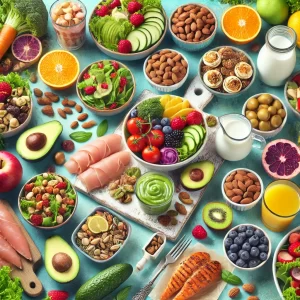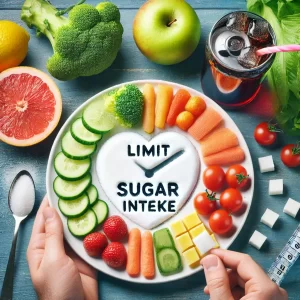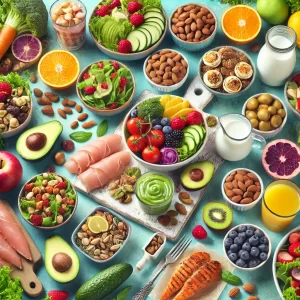The Low-Fat Diet for Weight Loss: A Beginner’s Guide to Heart-Healthy Eating
Introduction to the Low-Fat Diet
The Low-Fat Diet is a popular approach to weight loss that focuses on reducing the intake of dietary fats, particularly unhealthy fats like saturated and trans fats. By lowering fat intake, this diet aims to reduce overall calorie consumption while promoting heart health and fat loss. Unlike other weight loss approaches that emphasize  low-carbohydrate or high-protein intake, the Low-Fat Diet encourages balanced meals with moderate portions of carbohydrates and protein, but limits fats to a minimum.
low-carbohydrate or high-protein intake, the Low-Fat Diet encourages balanced meals with moderate portions of carbohydrates and protein, but limits fats to a minimum.
Fats are more calorie-dense than proteins or carbohydrates, with each gram of fat providing 9 calories compared to 4 calories per gram of protein or carbs. By cutting back on fats, particularly unhealthy fats, you can reduce calorie intake and promote fat loss. In this guide, we’ll explore how the Low-Fat Diet works, its benefits for weight loss, and practical tips for incorporating low-fat foods into your meals.
How the Low-Fat Diet Works for Weight Loss
The Low-Fat Diet works by reducing the amount of dietary fat you consume, which in turn lowers your overall calorie intake. Fats are calorie-dense, so reducing your fat intake can help create a calorie deficit, which is necessary for weight loss. Additionally, the diet encourages the consumption of nutrient-dense, low-calorie foods that support weight loss while promoting overall health.
Understanding Fats: Healthy vs. Unhealthy
Not all fats are created equal. The Low-Fat Diet focuses on reducing unhealthy fats, such as saturated fats found in red meats, butter, and processed foods, as well as trans fats found in fried and baked goods. These fats can contribute to weight gain, heart disease, and other health problems. On the other hand, healthy fats, like those found in avocados, nuts, seeds, and olive oil, are beneficial for heart health and should be consumed in moderation.
Low-Calorie, Nutrient-Dense Foods
While reducing fat intake, the Low-Fat Diet emphasizes nutrient-dense, low-calorie foods such as fruits, vegetables, whole grains, and lean proteins. These foods provide essential vitamins, minerals, and fiber without adding excess calories from fat, making it easier to create a calorie deficit and lose weight.
Key Components of the Low-Fat Diet
The Low-Fat Diet is built around reducing unhealthy fats and incorporating nutrient-rich, low-fat foods. Here are the key components of the diet:
- Lean Proteins: Chicken, turkey, fish, beans, and legumes are excellent sources of protein that are low in fat and support muscle maintenance and fat loss.
- Whole Grains: Brown rice, quinoa, oats, and whole wheat provide complex carbohydrates that offer sustained energy without excess fat.
- Fruits and Vegetables: These low-calorie, high-fiber foods are a cornerstone of the Low-Fat Diet and provide essential vitamins and minerals while promoting satiety.
- Low-Fat
 Dairy: Skim milk, low-fat yogurt, and reduced-fat cheeses provide calcium and protein while keeping fat intake to a minimum.
Dairy: Skim milk, low-fat yogurt, and reduced-fat cheeses provide calcium and protein while keeping fat intake to a minimum.
Benefits of the Low-Fat Diet for Weight Loss and Health
The Low-Fat Diet offers numerous benefits for weight loss and overall health. Here’s how it can positively impact your body:
1. Reduces Calorie Intake
By reducing fat intake, you naturally reduce your overall calorie intake, making it easier to create a calorie deficit and lose weight. Since fats are more calorie-dense than other macronutrients, cutting back on high-fat foods can significantly reduce the number of calories you consume.
2. Supports Heart Health
The Low-Fat Diet focuses on reducing unhealthy fats, such as saturated and trans fats, which are linked to an increased risk of heart disease. By cutting back on these fats and incorporating more heart-healthy foods like fruits, vegetables, and whole grains, the diet promotes better cardiovascular health.
3. Encourages Whole, Unprocessed Foods
The Low-Fat Diet emphasizes whole, unprocessed foods that are naturally low in fat and high in nutrients. This approach encourages a balanced, healthy eating pattern that supports long-term weight loss and overall well-being.
4. Helps Prevent Overeating
Low-fat, high-fiber foods like fruits, vegetables, and whole grains are more filling than calorie-dense, high-fat foods. This can help prevent overeating and keep you feeling full and satisfied while consuming fewer calories.
5. Promotes Sustainable Weight Loss
The Low-Fat Diet promotes a balanced, moderate approach to eating that can be maintained over the long term. By focusing on nutrient-dense, low-calorie foods, you can achieve steady, sustainable weight loss without feeling deprived.
Potential Drawbacks of the Low-Fat Diet
While the Low-Fat Diet offers many benefits, there are a few potential challenges to consider:
1. May Limit Healthy Fats
Some people may interpret the Low-Fat Diet as  a reason to avoid all fats, including healthy fats like those found in avocados, nuts, and seeds. It’s important to include moderate amounts of healthy fats in your diet to support brain function, hormone production, and overall health.
a reason to avoid all fats, including healthy fats like those found in avocados, nuts, and seeds. It’s important to include moderate amounts of healthy fats in your diet to support brain function, hormone production, and overall health.
2. Can Lead to High-Carb Intake
By focusing on reducing fat, some people may unintentionally increase their intake of refined carbohydrates, which can lead to blood sugar spikes and hinder weight loss. It’s important to choose whole grains and complex carbs instead of refined sugars and processed carbs.
3. Potentially Less Satisfying
Fats provide flavor and satiety in meals, so reducing fat intake may make meals less satisfying for some people. To counteract this, focus on adding flavor through herbs, spices, and low-fat cooking techniques, and include plenty of fiber-rich foods to stay full.
Tips for Success on the Low-Fat Diet
To get the most out of the Low-Fat Diet and achieve your weight loss goals, follow these practical tips:
1. Choose Lean Protein Sources
Opt for lean proteins like chicken, turkey, fish, beans, and legumes instead of high-fat cuts of meat. These protein sources provide essential nutrients without the added fats found in red meat or processed meats.
2. Focus on High-Fiber Foods
Fruits, vegetables, and whole grains are naturally low in fat and high in fiber, making them a key component of the Low-Fat Diet. These foods help keep you full and satisfied while reducing overall calorie intake.
3. Avoid Processed Foods
Many processed foods labeled as “low-fat” or “fat-free” are high in sugar and refined carbohydrates, which can hinder weight loss. Focus on whole, natural foods that are low in fat but high in nutrients.
4. Use Low-Fat Cooking Methods
Grilling, baking, steaming, and broiling are excellent low-fat cooking methods that allow you to prepare healthy, flavorful meals without adding extra fats. Avoid frying or using high-fat oils when cooking.
5. Include Healthy Fats in Moderation
While the Low-Fat Diet emphasizes reducing fat intake, it’s important not to eliminate healthy fats entirely. Include moderate amounts of heart-healthy fats from sources like avocados, nuts, seeds, and olive oil to support overall health.
Scientific Evidence and Case Studies
Research has shown that low-fat diets can be effective for weight loss and improving heart health. A study published in The Lancet found that participants who followed a low-fat diet experienced significant reductions in body weight and improved cholesterol levels compared to those on a higher-fat diet. Additionally, a study in The New England Journal of Medicine demonstrated that low-fat diets can reduce the risk of heart disease and stroke.
Who Should Try the Low-Fat Diet?
The Low-Fat Diet is a good option for individuals who:
- Want to lose weight while reducing their intake of unhealthy fats.
- Are focused on improving heart health and reducing the risk of heart disease.
- Prefer a balanced diet that includes carbohydrates and protein but limits fats.
- Are looking for a long-term, sustainable approach to weight loss.
Who Should Avoid the Low-Fat Diet?
The Low-Fat Diet may not be suitable for individuals who:
- Need to focus on increasing their intake of healthy fats for specific health conditions.
- Prefer higher-fat diets, such as keto or low-carb, which emphasize fat intake over carbs.
- Struggle with feeling satisfied on lower-fat meals and prefer more flavor and richness from fats.
Conclusion
The Low-Fat Diet is an effective and heart-healthy approach to weight loss that focuses on reducing unhealthy fats and incorporating nutrient-dense, low-calorie foods. By emphasizing lean proteins, whole grains, and fruits and vegetables, you can create a balanced meal plan that promotes long-term fat loss and overall health. With the right meal planning and mindful eating habits, the Low-Fat Diet can help you achieve your weight loss goals and improve your cardiovascular health.